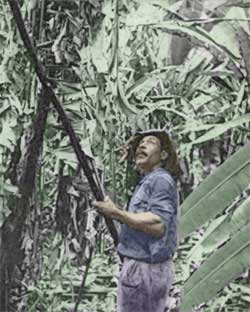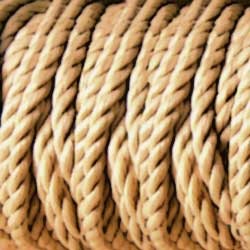
Abacá, Manila Hemp
Bananera, Guatemalan Worker trims leaves from abacá plant
United Fruit Company, Colliers Encyclopedia, ©1960
| Taxonomic Hierarchy | |
| Kingdom | Plantae – Vegetal, plants |
| Subkingdom | Viridaeplantae – green plants |
| Infrakingdom | Streptophyta – land plants |
| Division | Tracheophyta – vascular plants, tracheophytes |
| Subdivision | Spermatophytina – spermatophytes, seed plants, phanérogames |
| Infradivision | Angiospermae – flowering plants, angiosperms |
| Class | Magnoliopsida |
| Superorder | Lilianae – monocots, monocotyledons |
| Order | Zingiberales |
| Family | Musaceae – banana |
| Genus | Musa L. – banana |
| Species | Musa textilis Née – Manila-hemp, abaca, abaca |
| Musa textilis, Née, Taxonomic Serial No.: 506500 | |
Abaca (Musa textilis) is a large treelike herb cultivated in Borneo, the Philippines, and Sumatra, and belonging to the banana family, Musaceae, yielding one of the most valuable cordage fibers. It is a native of the Phillipine Islands and grows best on the slopes of volcanic mountains, but is not really a hemp. The name comes from a capital city of the Philippines. It was given its name, because hemp was for centuries a major source for fiber, so other fibers were sometimes named after it. The plant grows to a height of about twenty feet high and grows large oblong leaves. These leaves grow from the base of its trunk, and form a sheath around it. These sheaths contain the valuable fiber in the outer bark of the leaf stems, which are stripped off and then dried. The coarse fibers measure anywhere between five to eleven and half feet in length. These fibers are composed primarily of cellulose, lignin, and pectin. Once the fibers are separated, it is sold as manila. The fibers are combed out, some twisted tightly into yarns; several yarns are used to make a single strand, and several strands are combined to make a rope. The number of strands depends on the desired thickness of the rope. Finer fibers are used in weaving grass cloth and other textiles.

Abacá, Manila Hemp
adapted from istockphoto
Abaca fields are harvested by growers every three to eight months. They cut down mature plants, allowing the roots to remain in the ground, in which new plants grow from the old roots. Leafy sheaths are detached in strips, the pulp scraped off, leaving only the fiber strands, which are twisted into rope. More rope is made of Manila hemp because Abaca produces a strong fiber which is naturally resistant to salt water, sun, and wind. One inch of Manila rope requires a pull equal to about four tons to break it. Abaca is also used for some paper products such as Manila envelopes and Manila papers..
References
- Colliers Encyclopedia ©1960
- Essay by Christine W. Jarvis, Ph.D., J. E. Sirrine Professor, Clemson University
- World Book Encyclopedia ©2001
